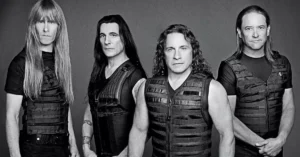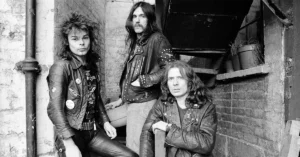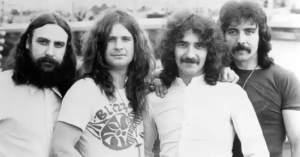Cannibal Corpse: The Undisputed Titans of Death Metal
Introduction: Brutality Without Compromise
Since their inception in 1988, Cannibal Corpse has stood as a pillar of uncompromising brutality, musicianship, and controversy in the world of death metal. With relentless speed, guttural vocals, and lyrics drenched in horror and gore, they’ve maintained a career that spans over three decades—outlasting trends, censorship, and critics. Despite (or because of) their extreme style, Cannibal Corpse is the top-selling death metal band of all time, a fact that underscores their lasting influence on extreme music.
Cannibal Corpse.
Origins: From Buffalo to Global Mayhem (1988–1990)
Cannibal Corpse was formed in Buffalo, New York, by members from three local bands—Tirant Sin, Leviathan, and Beyond Death. The original lineup included:
- Chris Barnes – vocals
- Jack Owen – guitar
- Bob Rusay – guitar
- Alex Webster – bass
- Paul Mazurkiewicz – drums
From the beginning, the band set itself apart with ultra-violent lyrics and shocking imagery. They signed with Metal Blade Records and released their debut, Eaten Back to Life, in 1990—a brutal blend of thrash-influenced death metal and explicit horror themes.

Cannibal Corpse.
The Barnes Era: Building a Legacy (1990–1995)
Eaten Back to Life (1990)
- Dedicated to deceased Death guitarist Chuck Schuldiner’s memory.
- Introduced a raw, visceral sound with a mix of horror movie imagery and gore.
Butchered at Birth (1991)
- Marked a turn toward more graphic themes and guttural vocal delivery.
- Album cover was banned or censored in multiple countries.
- Solidified their position in the death metal underground.
Tomb of the Mutilated (1992)
- Considered a genre-defining record.
- Includes fan-favorites like “Hammer Smashed Face”, later popularized by their cameo in Ace Ventura: Pet Detective.
- Lyrical content drew significant media criticism for violence and misogyny.
The Bleeding (1994)
- The final album with Chris Barnes.
- Showed more groove-oriented elements and clearer production.
- Became their best-selling album at the time.
After internal disputes and differing creative directions, Barnes left to form Six Feet Under. Enter George “Corpsegrinder” Fisher, the vocalist who would become synonymous with Cannibal Corpse’s next—and most enduring—era.

Cannibal Corpse.
The Corpsegrinder Era: Precision, Growth, and Consistency (1995–Present)
With Corpsegrinder’s powerful, dynamic vocal range, the band took on a more technical and precise approach to songwriting.
Vile (1996)
- First death metal album to debut on the Billboard 200.
- Featured tighter production, faster tempos, and increased technicality.
Gallery of Suicide (1998), Bloodthirst (1999), Gore Obsessed (2002)
- Continued refining their brutal style.
- Lyrics remained focused on murder, mutilation, and perversion—but with more cinematic finesse.
- Guitarist Pat O’Brien joined in 1997, contributing intricate solos and songwriting skills.
Kill (2006)
- Marked a sonic shift with a darker, cleaner production style.
- Widely praised for its modernized aggression and tight musicianship.
Evisceration Plague (2009), Torture (2012)
- Further evidence of their unrelenting consistency.
- The band balanced brutality with clarity, never sacrificing intensity for accessibility.
Cannibal Corpse.
Recent Albums: Enduring Relevance
Red Before Black (2017)
- Continued their legacy of gore-filled ferocity with memorable riffs and grooves.
- Showed no signs of slowing down creatively or technically.
Violence Unimagined (2021)
- Introduced Erik Rutan (Hate Eternal, ex-Morbid Angel) as a full-time guitarist.
- Received critical acclaim for its precision, energy, and balance of classic and modern death metal.
Chaos Horrific (2023)
- Reaffirmed their dominance in the genre.
- Blended relentless blast beats with thrash-inspired riffs and cinematic horror themes.
Cannibal Corpse.
Style and Themes
Cannibal Corpse is widely recognized for:
- Musical Traits:
- Fast tremolo picking, palm-muted riffs
- Rapid double-bass drumming
- Growled, low-register vocals
- Complex song structures
- Lyrical Themes:
- Gore, necrophilia, cannibalism, torture, serial killers
- Influenced by horror fiction and splatter films
Despite controversy, bassist Alex Webster often emphasizes that the lyrics are fictional and symbolic, much like horror films, rather than endorsements of real-world violence.
Censorship and Controversy
Cannibal Corpse has faced censorship globally:
- Albums were banned in Germany until 2006.
- Covers were replaced with censored alternatives in several countries.
- Australian authorities restricted their performances of early material.
- Politicians like Bob Dole and Joe Lieberman cited them as negative cultural influences in the 1990s.
Yet, these controversies only enhanced their reputation as true outsiders and rebels in extreme music.
Discography Highlights
- Eaten Back to Life (1990)
- Butchered at Birth (1991)
- Tomb of the Mutilated (1992)
- The Bleeding (1994)
- Vile (1996)
- Gallery of Suicide (1998)
- Bloodthirst (1999)
- Gore Obsessed (2002)
- The Wretched Spawn (2004)
- Kill (2006)
- Evisceration Plague (2009)
- Torture (2012)
- A Skeletal Domain (2014)
- Red Before Black (2017)
- Violence Unimagined (2021)
- Chaos Horrific (2023)
Legacy and Influence
Cannibal Corpse has:
- Inspired countless death metal and grindcore bands.
- Maintained a stable lineup and creative vision for over three decades.
- Proved that extremity, when combined with consistency and authenticity, can achieve longevity.
From underground clubs to international festivals, they’ve never diluted their identity. With George “Corpsegrinder” Fisher’s neck-defying headbanging and Alex Webster’s bass wizardry, Cannibal Corpse continues to be the gold standard in death metal.





